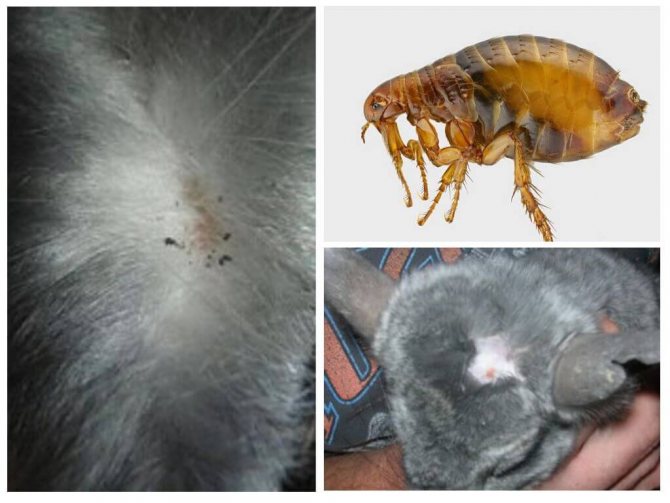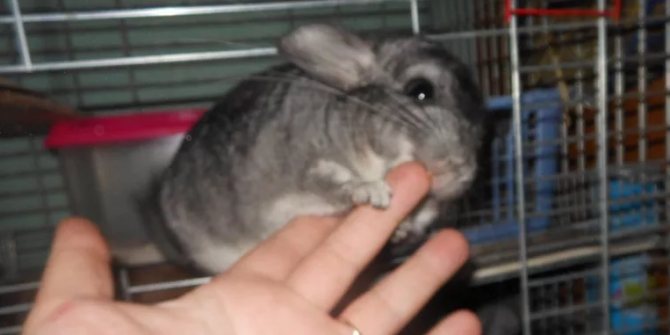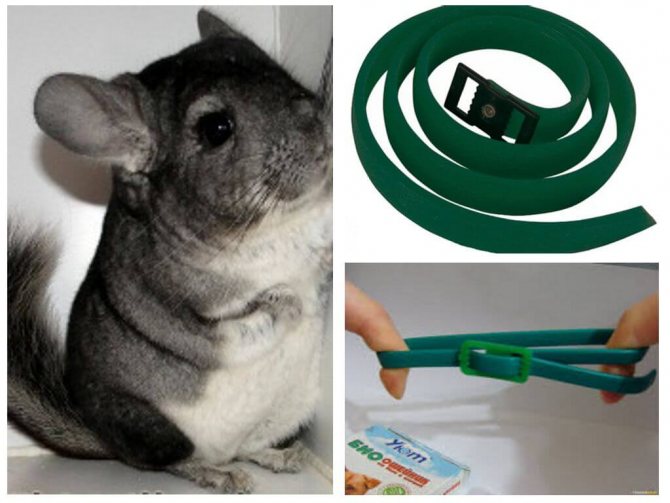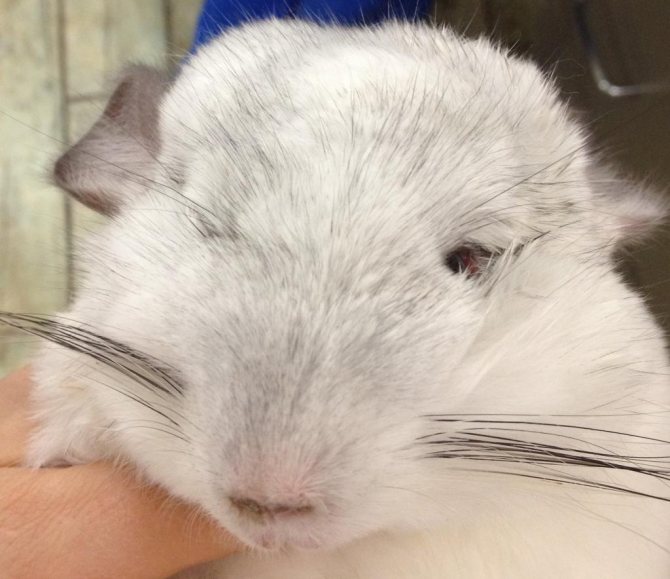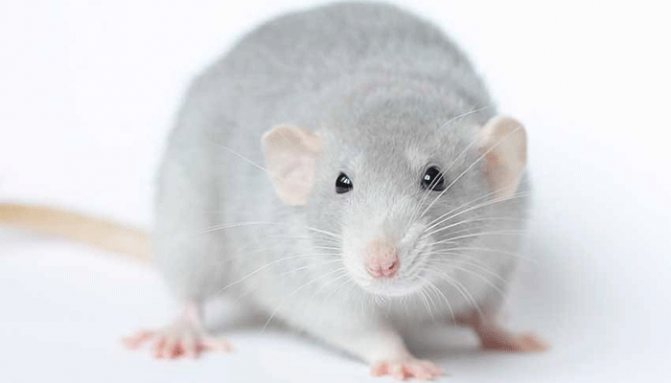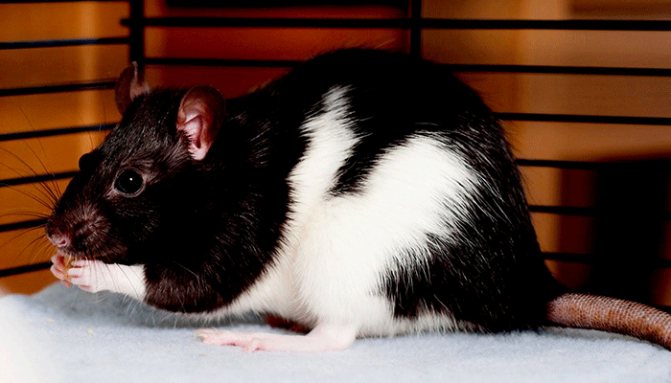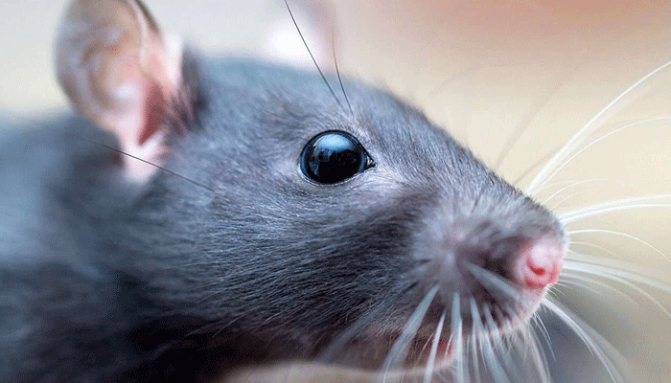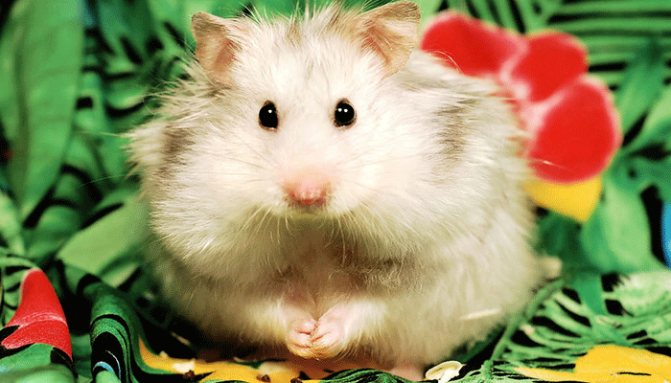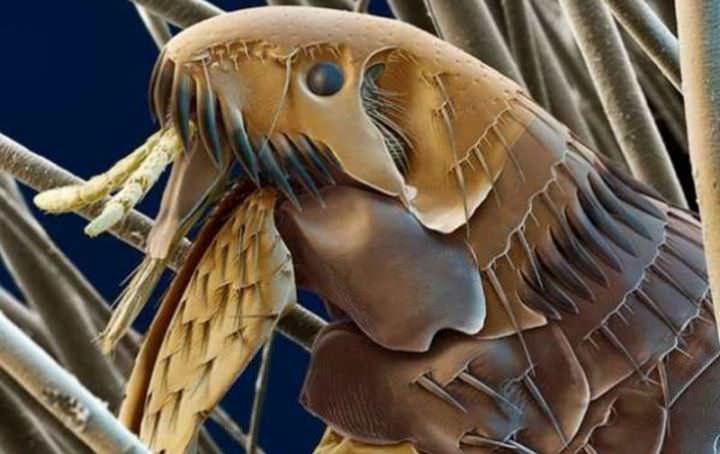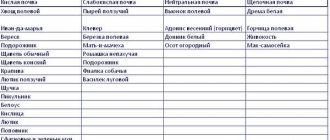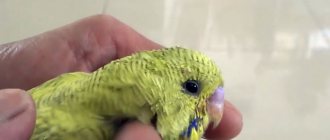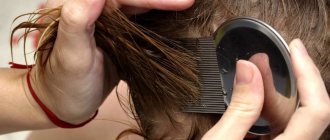If you periodically notice how the chinchilla itches, you should not immediately sound the alarm. All animals do this sometimes, but if the animal bites itself and itches constantly, examine it. Based on the condition of the rodent's skin, it is determined whether he needs the help of a veterinarian, or a small correction of care is enough.
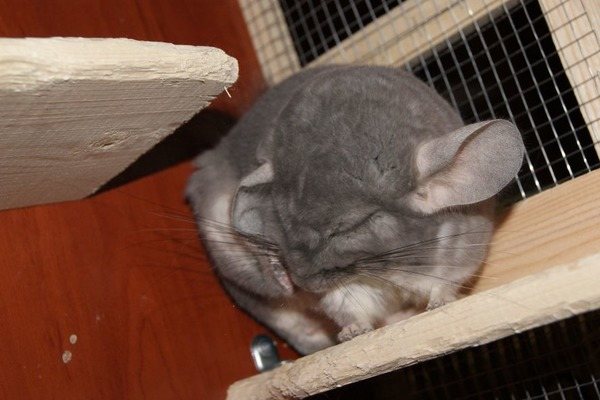
If the chinchilla does not lose hair, it has clear skin without redness, blisters and peeling, it can itch due to the dry air in the room. In this case, limit bathing in the sand once a week or use a humidifier. Otherwise, you need to show the animal to a specialist and carry out the treatment recommended by him.
List of the most common diseases in chinchillas:
- Stroke
- Overheat
- Fur diseases, versicolor
- Soft feces, diarrhea
- Bloating
- Constipation
- Poisoning
- Foreign body entering the throat
- Cold
- Hooks on teeth
- Eye diseases
- Ear diseases
- Diseases of the genitals
- Wounds and trauma
- Rectal prolapse
- Parasites in chinchillas
To monitor the health of a chinchilla, you need to know the physiological indicators.
- Chinchilla temperature ranges from 36 to 37.5 ° С
- Pulse 100-150 beats per minute
- Breathing is normal - 90-110 breaths per minute
- It is also necessary to monitor the weight of the chinchilla so that it does not become obese or depleted. Below is a table of what weight and at what age a chinchilla should be.
STROKE
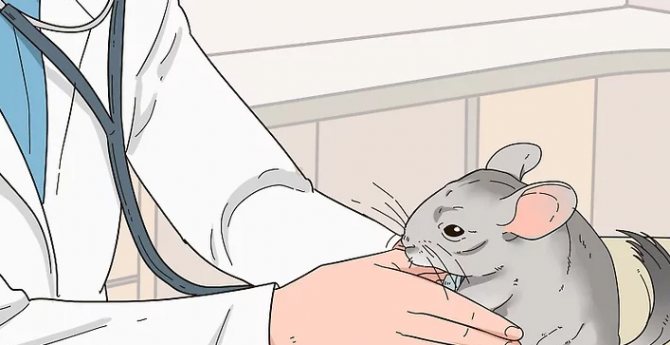

Not the most common disease in chinchillas, but very dangerous, so I put it in first place. A stroke is a condition in which cerebral circulation is impaired for several minutes or hours. At this moment, tissue death occurs, ruptures or clogging of the vessels of the brain.
Stroke symptoms in chinchillas:
- Convulsions
- Impaired coordination
- Rworth
- Falls over or lies on its side
- Large amounts of saliva
- Doesn't smell
- Ultimate paralysis (paws failed, etc.)
With these symptoms, you need to urgently contact your veterinarian. The account goes on for minutes, if you do not help in time, the chinchilla will die. If your pet is dear to you, then do not try to save money on the vet and try to cure it yourself.
Causes of Stroke in Chinchillas:
- Severe stress
- Severe injury to the head or spine
- Strong departure
- Abrupt change in room temperature
- Acute lack of vitamin B
- Severe fright from external sources, such as sounds
- Improper care and feeding for a long time
- Untimely or inappropriate treatment of other diseases
Like a pet for a child
No, this is not a very good choice. Children are too fast, dexterous, harsh, loud for chinchillas. This makes them bite children more often than adults.
They are softer creatures than cats, dogs that tolerate more (not literally). At the same time, a lot of care and attention are required.
Unlike cats, dogs, which sometimes tell you that something is wrong, chinchillas rarely (if ever) show signs that they are not feeling well. Many hide diseases for weeks, months. When they are sick, the owners will not know about it until it is too late.
Overheating (hyperthermia)
A very dangerous and life-threatening condition. Chinchillas feel comfortable at temperatures up to + 18 ° C. The maximum permissible temperature is + 25 ° C, higher is dangerous to health. They don't have sweat glands, so they can't fight off too high a temperature.


When the temperature rises above + 25 ° C, the chinchilla begins to feel worse and can get overheated, and at a temperature of + 30 ° C, overheating can occur instantly and within a few hours the chinchilla will die. It is important to identify overheating in time and start treating it.
Symptoms that indicate overheating:
- Lethargic, practically motionless
- Seizures
- Convulsions
- Lying on its side or stretching
- Thick saliva
- Tongue bright red
AMBULANCE!
Heatstroke requires emergency treatment. You can't wait, you need to act right away, otherwise the pet may die in a matter of hours. The disease goes on instantly and here we need the help of a veterinarian who will give the necessary medications. Call a specialist at home or take your pet to the nearest veterinary clinic on your own.
First of all, you need to help the chinchilla with improvised means to alleviate its condition. Wet the pads and the outside of your ears with cool water. Move the chinchilla to a cool, ventilated room without drafts. Or you can put it in a metal bathtub or on a cold tile floor. Try giving your chinchilla water to drink.
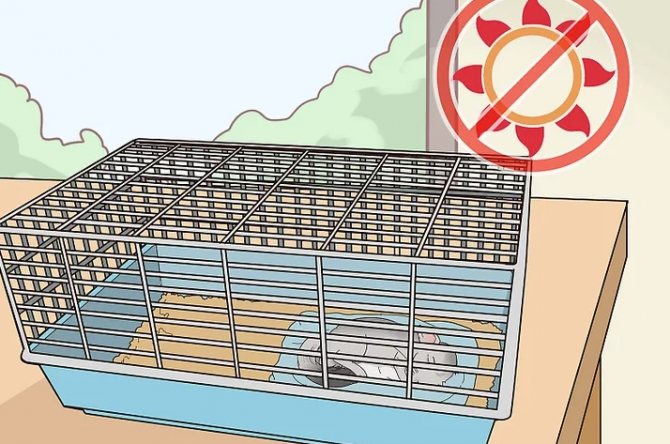

It is very important that you do not cool it down and never put it in the refrigerator. Rapid cooling will lead to new diseases or death of the animal.
Why is it important to take your chinchilla to the vet?
The veterinarian has invaluable experience that will help to quickly relieve the temperature and bring the pet to a normal state. In addition, the doctor will be able to assess the condition and determine whether other organs are damaged, and then prescribe the necessary treatment.
!!! If the necessary measures are not taken in time, then there will be irreversible changes.
If the overheating was strong, then you will have to leave the animal for several days in the vet. clinic until complete recovery. This pleasure is not cheap, but here you decide whether to spend money on treatment or leave the chinchilla to chance.
How to cure overheating yourself.
ATTENTION! This information is provided by the owner of the chinchilla and taken from the forum. We do not guarantee a 100% cure for your chinchilla, so we recommend that you contact your veterinarian. We left this method of treatment in case the owner does not have a single veterinarian nearby.
OWNER'S STORY ON OVERHEAT TREATMENT
It happened late at night, the chinchilla showed all the symptoms of overheating. Calls to the vet known to me. clinics were unsuccessful. First of all, the chinchilla was transferred to a cool room and ice was applied to the head through a towel. As a result, I managed to get through to one of the clinics, where they could only help with a prescription. In addition, they said that such a fragile creature is unlikely to be helped, but I decided to give it a try.
Here is what they advised us and in the end it saved the chinchilla:
Prednisalone - 0.1 / m
Euphyllin (2.4%) - 0.1 s / c
Furosemide (lasix) - 0.2 s / c
Added at will: Sulfocamphocaine 0.3 IM
In addition, a little more Furosemide (lasix), because the chinchilla did not pee from the first portion of the medicine.
The chinchilla was still kept cool, with the cold applied to his head and ears. Now all that was left was to wait for everything to work.
Closer to 4 in the morning, the first signs appeared that the medication had helped. The head stopped twitching nervously, peed a couple of times and at least some movements began. An hour after the improvements, they stopped applying cold and removed them to a cage separate from other animals. Having put in the cage, they immediately poured water with glucose, which she happily drank. A few minutes later she went to bed.
After a little sleep, of course, we too, injected another 0.3 Sulfocamphocaine i / m. After a couple of hours, she had already started eating hay. On the same evening, the animal became very active and showed no signs of feeling unwell.Just in case, we transplanted her into a common cage only every other day, constantly observing and drinking plenty of water.
The chinchilla survived thanks to the instant help. We did not bring her to the point where they are already starting to fall, but decided to start treatment immediately.
Now it's worth telling why this happened. It was hot summer weather, during the day they naturally sat in a cage. And in the evening, when it got pretty cool, according to my feelings, the chinchillas begged for a walk with their eyes. The coolness turned out to be deceiving, the chinchillas frolicked for a long time and ran a lot. Of the 2 chinchillas, only the girl suffered, for what reason I do not know, maybe she is weaker, but most likely this is due to the excess weight she suffers from.
I highly recommend that you do not walk with chinchillas in hot summer weather. Even at + 22-25 degrees with intense physical activity, they can get strong overheating.
Diarrhea and soft feces
It is very common in chinchillas. It is quite easy to treat, but if you delay with this, then there can be serious consequences. In general, a chinchilla is a very fragile animal, so any mediocre disease should be treated immediately.
Symptoms of diarrhea in chinchillas:
- Liquid feces, dirty anus. Usually have an unpleasant odor
- Lack of appetite
- The body is dehydrated, rarely goes to the toilet
- Becomes lethargic and not mobile
There are many reasons for diarrhea and most often from bacteria or parasites. Rarely, but still there is diarrhea from stress.
The main causes of diarrhea:
- Change of feed
- Poor quality feed that contains pesticides or pesticides.
- Underdried or rancid food
- Departures from water also happen. If the animal is diarrhea, then thoroughly rinse the drinker and disinfect, and then give water from another source.
- If diarrhea is in the cubs that the mother feeds, then most likely she is sick.
- In rare cases, diarrhea is associated with diseases of the stomach and other organs.
How it treats diarrhea in chinchillas.
The first step is to inspect your pet's cage and food. Look carefully for mold or rot, this will immediately indicate that the chinchilla has simple poisoning and is easy to cure. Immediately wash and disinfect the entire cage, replace the bedding, rinse the drinker thoroughly and add new feed with clean water.
If the boluses (faeces) have a strong and unpleasant odor, then it is better to contact your veterinarian, as this indicates a serious illness.
If you decide to cure a chinchilla yourself, then there are two ways to treat diarrhea at home.
- Traditional medicine
- Medicines that are sold in any veterinary pharmacy
If the boluses are not yet too liquid, but simply mild, it is best to start without medication. In case of loose stools, urgently start medication or take to the veterinarian.
For detailed instructions on how to treat diarrhea in chinchillas at home, read a separate article on our website.
How fleas get into the apartment
If you are wondering why the chinchilla itches and bites itself, check it for fleas, even if it is the only animal in the house. After all, bloodsuckers can get into a city apartment or a private house in several ways:
- flea larvae or young, active insects can be brought on clothes and shoes;
- through ventilation shafts, openings;
- with sand and feed, even purchased from the store;
- and the most common option is with pets, who prefer warm, damp places for walking - basements, attics, sheds.
Important! If fleas are found, the fight should be started immediately, because one mature individual lays a large number of eggs per day, which, under favorable conditions, turn into an adult insect within a few days.
Bloating
Bloating, or as it is also called flatulence, tympania, is a rather serious disease.Bloating is 2-3 times harder for a chinchilla to tolerate than constipation or diarrhea. Gas accumulates in the stomach, from which they experience severe pain, because they do not know how to release them, as other animals do.
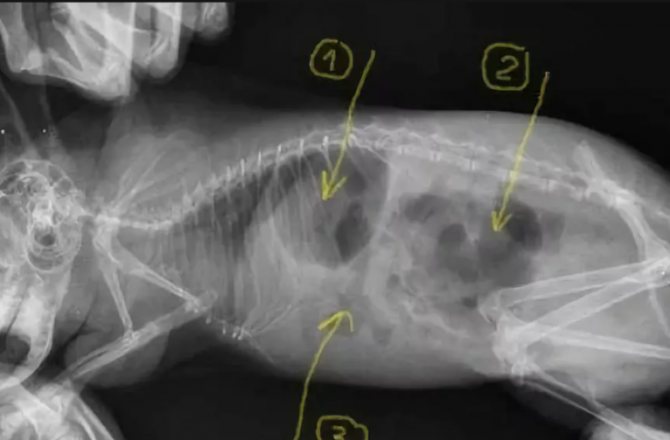

Symptoms of bloating:
- The abdomen is very hard, takes on the shape of a ball
- Reacts even to light touches on the stomach
- Stops eating
- Breathing hard
- Loss of activity
- Body temperature goes down
Checking your pets regularly can help detect bloating early and treat the disease quickly. If you find the disease after 2-3 days or self-treatment does not give any results, then you need to urgently contact your veterinarian. Bloating is very dangerous to your health and can be fatal.
Reasons for bloating:
- When feeding plentifully with green food, legumes and fresh foods
- Physical inactivity when the animal moves very little
- If it is a cub, the bloating could be due to separation from its mother.
How is it treated
As usual, there are two ways, without medication and with their use.
If the animal is feeling relatively well, then you can start with the simplest treatment:
- Massage your tummy. Do this very gently and smoothly.
- If there are several individuals in the cage, then it is better to transplant them into a separate cage and not give food for the first day.
- Put a clean drinking bowl, and also give a decoction of chamomile, 1 teaspoon 5-6 times a day.
- Put the animal on a diet, first give only high-quality hay and nothing else. In no case should you indulge in delicacies.
- When the animal becomes more active, and the abdomen ceases to look like a ball, you can slowly transfer to normal food. On the first day, give a small portion of feed, while leaving hay as the main diet.
Medicines are needed for treatment.
To suppress the gases and the treatment went faster, the help of medication is needed. It is necessary to purchase the following drugs: Powdered activated carbon, Norsulfate, Etazol, Biomycin.
Treatment must be accompanied by infusions and decoctions of chamomile or dill. Read more about chinchillas bloating treatment and medication instructions in this article.
Checking your chinchilla for fleas
Fleas prefer warm, humid habitats, ideally the fur of warm-blooded animals. This refers to the most common types of parasites - feline and canine bloodsuckers, which do not differ from each other in their way of life. At the same time, they lay eggs on litters and other warm, hidden places.
Having brought a playful, affectionate animal to your house, immediately carry out a preventive examination. Especially if he itches and bites the skin. Blood-sucking insects prefer to dwell on their paws and ears, since the hair is less common there compared to the body. In the absence of fleas, the skin is clean, even, without ulcers and combs. If the above signs are found, then this indicates the presence of parasites.
Constipation in chinchillas
Constipation occurs for a variety of reasons and should be treated as soon as possible. Usually constipation arises from poor food, food changes, chinchilla immobility, gastrointestinal diseases, infections, etc. Sometimes constipation occurs from severe stress and fear.
A more detailed article on constipation here
Constipation symptoms:
- Boluses (poop) become smaller than usual
- There are fewer boluses, in advanced cases there are no boluses at all
- Refusal to eat
- Immobile and sluggish. In some cases it sits in the corner with its tail between its legs.
- Sometimes makes pitiful sounds
Constipation is not difficult to cure at home, but if the illness lasts for several days and there is no improvement, then it is better to contact your veterinarian. It is especially important to consult a doctor if there are no boluses for more than 2 days, the animal can quickly die.
If your chinchilla has constipation, then go to another article on our website with decoction recipes and a list of medicines.
If there are no serious violations, then you can start self-treatment of constipation:
- The most important thing is to give as much water as possible. If the animal does not drink on its own, then you can drip into the mouth from a regular syringe
- It is necessary to clean the cage and get rid of all food. Put in good fresh hay.
- If the boluses come out, then you can start with decoctions, without the use of laxatives. Flax seed decoction works very well. It must be boiled and insisted until the water becomes thick. Give the chinchilla from a syringe 2-3 ml 3 times a day.
- If there is no improvement, then a laxative should be given. You can find laxative recipes here.
- For severe constipation, an enema with salted water is given.
Flea treatment for a rodent
Only large-scale disinfection measures will allow you to get rid of fleas not only on the skin of the animal, but also throughout the apartment. Immediately after detection, it is necessary to remove all inhabitants from the house and disinfect with special preparations - spray or aerosol. You need to carefully process the places behind the skirting boards, floor cracks, carpets, upholstered furniture. After that, the apartment is cleaned up with washing and using a vacuum cleaner. All pets are also treated with insecticides and flea collars.
Chinchilla fleas, what can not be done?
- Use antiparasitic shampoos made for larger pets.
- Bathing an animal, for which wet fur can turn into not only serious stress, but also a cold.
- Use chemicals such as Bars or Stronghold, which can cause poisoning.
Important! 1-2 treatments of the apartment will be enough for the insects to disappear!
Flea remedies
When using antiparasitic agents intended for cats and dogs, it should be borne in mind that the chinchilla is much smaller in size than other pets. This means that the dose of the chemical must be reduced. Special sprays, drops can cause significant harm to the animal. Therefore, the best option would be a special collar that is used for cats and dogs. The product is less toxic than chemicals and safe for health.
Cell processing
Can a chinchilla have fleas after processing an apartment? Sure! If you do not disinfect the cells in which the parasites lay their eggs. Therefore, you need:
- wash the litter in hot water;
- clean out the cage;
- treat with disinfectants;
- wash it with a solution of vinegar and tar soap;
- add fresh hay or sand.
Poisoning
Poisoning is a dangerous and serious disease. There are many reasons for poisoning, most often from bacteria or poor-quality feed. Check the chinchilla's throat first because the symptoms may be similar when a foreign object gets in its airway.
Symptoms of food poisoning of chinchillas:
- Vomiting or urge to vomit
- Mucus, foam around the mouth or nose
- Weakness and unwillingness to move
- There may be bloating in the stomach
- Sometimes accompanied by diarrhea
Poisoning can cause new diseases and often lead to death if treatment is not started on time. If you see that the condition of the animal is worsening every hour or two, then it is better to contact your veterinarian before irreversible consequences occur.
If your pet feels normal and stable, you can heal it yourself.
It is quite difficult to treat the departure and it is best to contact your veterinarian. Unfortunately, there is very little information on treatment on the Internet, in this article we have collected all the instructions on how to independently help a chinchilla with food poisoning.
Foreign body stuck in the throat
Sometimes foreign objects get stuck in chinchillas, most often these are pieces of food.
Jam symptoms:
- Saliva flows profusely
- Vomiting or only urging
- Mucus around the mouth or nose, less often foam
- Sneezing
- Abnormal breathing, often heavy
It is quite difficult and dangerous to get a foreign body yourself; it is best to entrust this matter to a veterinarian. If the item is large, then there is a risk of losing your pet in just a couple of hours.
Symptoms are very similar to poisoning, so a visit to the vet will be doubly beneficial. The doctor will make an accurate diagnosis, remove the foreign body if there is one, and if it is poisoning, he will give the necessary medicines.
If you decide to get a foreign body yourself, then first read the article on how to do it and step-by-step instructions.
Reviews and comments
+3 Anna 10/12/2015 21:00 My daughter half a year ago, a friend gave the Dutch fold rabbit, just "in good hands", along with the cage. Later I realized that, apparently, people were tired of looking after him. The rabbit itched funny and shook its head. And soon I realized: the rabbit has fleas. In a veterinary pharmacy, I was advised to take drops from a block for cats. I dripped to both the rabbit and the cat, and everything went away. Our cat does not go outside, so I refused the collar. I washed the cage and all the items in it well with soap and hot water.
Quote
+1 Irina 11.11.2017 18:45 How much to wear a chinchilla flea collar so that they completely disappear
Quote
Colds
A chinchilla can easily catch a cold, a few minutes in a draft will be enough for her and she will already get sick. Due to hypothermia, colds appear very rarely, because animals love coolness and are without problems in temperatures up to +5 degrees Celsius.
With a cold, chinchillas develop the following symptoms:
- Coughing or sneezing
- Runny nose, mucus around the nose
- A sluggish, immobile state
- Eyes are a little watery and have lost their "shine"
The common cold is not a very terrible disease, but its symptoms can be similar to other dangerous diseases. The chinchilla has a weak body and it can easily get pneumonia, and you will treat it with a simple chamomile.
It is recommended that you immediately contact your veterinarian for an accurate diagnosis and proper treatment. Sometimes the symptoms appear from completely different diseases and the chinchilla needs urgent help.
If you are sure that your pet has a simple cold, then read the article on treating a cold in chinchillas.
Hypothermia and colds
Thick and dense fur perfectly protects from cold weather, however, the absence of sweat and sebaceous glands leads to the fact that wet fur immediately loses its properties. If your pet gets wet, you should immediately wrap it in a soft towel and place it in a warm place until it dries completely.
It must be remembered that your pet is extremely sensitive to hypothermia and drafts. Colds for these animals often end fatally, since bronchitis and bronchopneumonia develop very quickly against the background of hypothermia.
At the first signs of a cold (sneezing, nasal discharge, shortness of breath), an urgent appeal to the veterinarian is necessary.
Hooks on teeth
If you do not follow the chinchilla's teeth, then it may die, since if the teeth grow incorrectly and turned into hooks, then eating becomes impossible.
The presence of the hooks can be seen. Here are the symptoms that confirm this:
- Eats very carefully, picks out individual small pieces.
- Trying to crumble food
- The jaw does not fully converge
- Saliva around the mouth
- If the illness lasts a long time, then the boluses become smaller and gastrointestinal diseases develop.
There is a detailed article on hooks and how to get rid of them on our website, but I highly recommend contacting your veterinarian. The procedure is rather complicated and dangerous.
Eye diseases
Determining that your chinchilla has an eye disease is not so difficult. But it is difficult to cure them, and it is even more difficult to determine which eye disease is developing.
You can treat eye diseases in chinchillas on your own at home, but first you need to see a doctor. He must diagnose, because if the disease is infectious or in the last stages, then without certain drugs or procedures, the chinchilla cannot be helped.
The main symptoms of eye disease:
- Sluggish state
- Sourness of the eye, suppuration, great tearfulness
- In rare cases, there is foam on the eye
Please note that if the eye is simply watery, then this may be the cause of another disease and try to make sure that there are no more pronounced symptoms of another disease.
A list of eye diseases that are most commonly observed in chinchillas:
- Cataract is an eye disease in which the lens becomes noticeably cloudy. It mainly manifests itself in individuals in old age, very rarely in young ones. The animal's vision is impaired, and as a result, it can completely lose it. Immediate consultation with a veterinarian is necessary. The disease can be easily treated in a veterinary clinic under the supervision of a doctor, but you should not try to cure a cataract on your own.
- Inflammation of the cornea - this disease manifests itself due to the ingress of filler microparticles, sand, dust and other things into the eye. It is treated very simply by using antiseptic ophthalmic preparations. But, again, we want to emphasize that it is highly not recommended to self-medicate.
- Inflammatory eye diseases - most often we are talking about conjunctivitis. Inflammatory diseases can develop as a result of colds and viral diseases. Often accompanied by the discharge of pus from the eyes. They require immediate treatment, prescribed strictly by a specialist.
- Colds - if you are faced with this problem, then we will not limit ourselves to discharge from the eye. To these symptoms will be added cough, mucus from the nose, sneezing, and more.
- It is also important to note that the cause of tearing from the animal's eye can be dental problems - overgrown roots of the teeth, this problem can only occur in chinchillas older than two years.
Ear diseases in chinchillas
In chinchillas, ear diseases do not appear so often, but usually it is otitis media. Otitis externa is a disease of the ears when the outside of the ear becomes inflamed.
Symptoms of otitis media in chinchillas:
- The animal scratches its ear or heads against the walls of the cage
- Scratching its ears
- Sometimes pus comes out of the ears and should be removed.
To treat otitis media in chinchillas, it is necessary to remove pus using ointments containing zinc (or fish oil). You should not use alcohol-based products, because they can harm the delicate ears of the chinchilla.
To prevent the disease from developing further, it is necessary to drip antibiotics into the ear. Read more about the treatment of ear diseases here.
If the chinchilla has other symptoms of a disease associated with the ears, then you should contact your veterinarian. He will make an accurate diagnosis and prescribe treatment that can be carried out at home. Sometimes they develop rare diseases that you cannot find on the Internet for treatment.
Where do fleas come from?
Many owners are worried about the question: how can a chinchilla pick up fleas if it never leaves the house and rarely leaves the cage? In fact, being an outdoor animal is not at all necessary in order to get to know fleas better. It is enough if other animals live in the house besides the chinchilla.
The basement is one of the ways fleas enter the house
- Especially dangerous in this regard for rodents is a dog that is on the street every day and can bring fleas at any moment. The presence of an anti-flea collar in a dog does not guarantee its absolute sterility in this regard. Fleas can get on the dog on the street anyway. Therefore, it is very important to timely treat the dog for fleas using folk or home methods.
- Fleas move quickly and over long distances, feeling the blood of warm-blooded animals. A cat can also spread fleas.
- Other ways fleas enter the house are from basements and attics, where they parasitize on stray animals and birds. Ventilation shafts only make this process easier.
- Sometimes a chinchilla enters the house already infected with parasites, having received a problem from a guinea pig, which can be eliminated with the help of folk or purchased means. Therefore, it is necessary to inspect the animal immediately after purchase, or even before that.
- Another source of danger is chinchilla hay, which is sold at pet stores and poultry markets. It can be infested with fleas. Therefore, before putting a favorite delicacy in the cage, it must be carefully examined.
Hair ring on the penis
Sometimes the male has a dangerous problem, namely the formation of a hair ring on the penis. There are no distinct symptoms as such, but this disease is very easy to see by examining the male genitals. You will immediately see that the penis does not come back inside, it looks swollen and has changed color.
Causes of occurrence:
- With active mating.
- The male, for some reason, was unable to completely clear his
Hair accumulates on the penis and a hair ring forms, which is a serious danger to the male. Over time, the ring squeezes the penis and it becomes more difficult for the chinchilla to urinate. If you do not take action in time, you can seriously harm or even lose your chinchilla.
The hair ring is removed on its own, as shown in this article. It is best to go to your veterinarian because the penis is a very important and sensitive organ.
Signs of a problem
Thick fur to some extent protects chinchillas from bloodsuckers. But it does not have the same density everywhere. On the face, paws, in the area of the ears, wool is much less common and it is there that fleas can be found in animals.
The presence of fleas can be identified by a number of characteristic features:
- The chinchilla becomes restless.
- Itching and scratching appear.
- At the site of the bites, as a result of injury, growths are formed that resemble warts.
- Black dots resembling grains are found in the coat.
- In severe cases, fur begins to fall out.
Chinchillas can develop anemia and dermatitis. Since fleas are carriers of diseases, theoretically, the animal can also become infected with helminths.
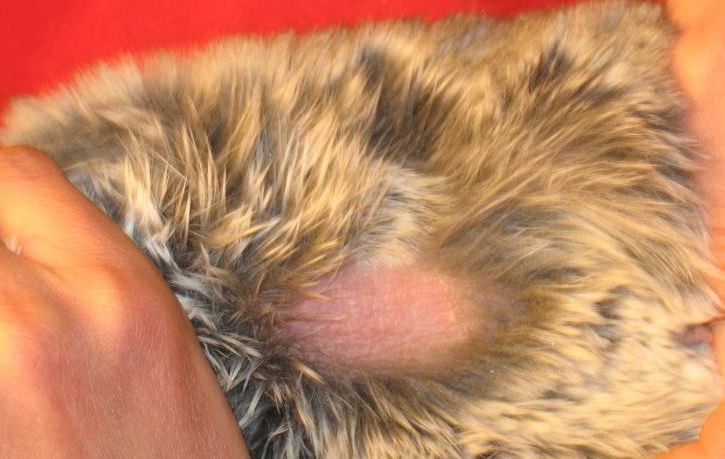

In severe cases, in the presence of fleas, fur begins to fall out
Wounds and trauma
The shortest point, because treating injuries on your own is not worth it. You wouldn't cast a cast on your friend if he breaks his arms, will you?
Sometimes chinchillas are injured due to falls, fights among themselves and other unpredictable events. If you find wounds, sprains or fractures in a chinchilla, then urgently take it to the veterinarian in order to fix everything in time. Don't try to heal yourself, you can only make it worse.
Any fractures or minor injuries can lead to the death of the animal, so do not save money and take the chinchilla to the veterinary clinic.
Other reasons for bites
Taste testing
If your fingers smell like a particularly tasty scent, your pet may bite lightly to “taste”, or bite harder, believing your finger is a delicious treat. This type of trauma is not performed in fear or anger. To prevent, wash your hands before handling chinchillas.
Hair care
Sometimes they gently bite the hand and fingers. This is the type of grooming that rodents usually do with each other. Usually one chinchilla looks after another for a few minutes, then changes places. Your pet may bite lightly and then stop. Waiting to be reciprocated.
Inconvenience signals
From time to time, if the pet does not want to be held in his arms or wants to urinate, he gently pinches his hand with his teeth several times. If you ignore the cues, it will bite harder to convey meaning, or urinate on you.
Lichen and fungus
Sometimes hair falls out on the body of chinchillas, this is very noticeable and very spoils the appearance of the animal. To understand that chinchilla versicolor does not need any list of symptoms, it is already very noticeable.
The reasons for depriving:
- From stress or fear
- Weak immunity
- High humidity in the room
- Lack of vitamins
- Unsanitary conditions
- Contact with infected individuals
How does versicolor (fungus) manifest
- Skin lesions in separate areas
- Partial or complete absence of fur in the affected area
- Dry skin, peeling in places
- In places of lesions, the skin turns into a dense crust
- Purulent discharge occasionally appears, but this is most often due to a neglected disease
We have compiled for you several instructions on how to treat lichen at home in this article. Naturally, it is best to contact a veterinarian to examine the animal and decide whether treatment with folk remedies is suitable for him or whether it is already necessary to urgently give the animal medicine.
Heatstroke
Chinchillas do not tolerate strongly the high temperature of the environment. The highest limit of the temperature regime in the room for a chinchilla is 24 degrees. High humidity combined with air temperatures above 24 degrees can lead to heatstroke. The main symptoms of the disease: the chinchilla lies on its side and breathes quickly, the ears turn red, the body temperature rises to 38 degrees, saliva drips from the mouth, convulsions. Heatstroke can kill the animal. Chinchilla urgently needs to be moved to a cool, dark place. A cool compress should be used to lower body temperature. At the same time, it is dangerous to sharply lower the body temperature of the animal, because the compress should be only slightly cool, but not icy. With a slight heatstroke, the chinchilla will quickly recover and begin to show activity. With severe overheating, irreversible processes occur in the body. The animal must be shown to the doctor as soon as possible.
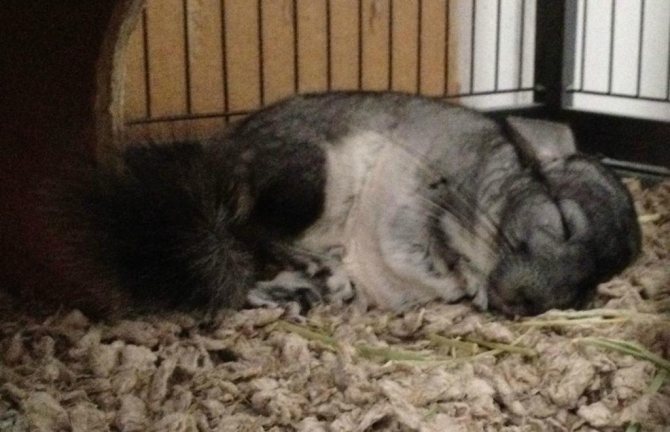

To avoid heatstroke, the cage should not be placed in direct sunlight. In winter, it should not stand next to the battery. On hot days, you can put bottles of cold water in the cage. In this case, it is necessary to take care of good ventilation so that hot air does not stagnate in the cage. The chinchilla must have access to fresh drinking water at all times.
The uterus of the female fell
If you do not take the chinchilla to the hospital in time, then this disease will die in a fairly short time.
As soon as you notice that the uterus has fallen out, you urgently need:
- Take the chinchilla to the vet to have time to help her
- On the way to the doctor, it is necessary to water the uterus with Chlorhexin, otherwise it will dry out or the chinchilla will become infected with something.
The uterus usually falls out after childbirth, so if you are breeding chinchillas, then keep an eye on them during the birth of cubs.
Pododermatitis
Pododermatitis is a disease of the feet characterized by desquamation in the initial stage and the appearance of cracks and ulcers in advanced cases. It is believed that the predisposing factor in the development of pododermatitis is the keeping of animals in cells with a mesh floor.
If ulcerated areas appear on the feet, it is not uncommon for pathogenic microflora to enter and develop in them. It is necessary to keep the cage clean and periodically check the condition of your pet's legs. As a rule, the animals, which are sometimes allowed to walk around the apartment, are the least susceptible to this disease.
Rectal prolapse
The rectum can fall out in both the male and the female. The rectum of chinchillas does not fall out just like that, it usually happens after long-term diseases that have not been treated, for example, constipation.
You can only entrust the intestine to the veterinarian in order not to harm the animal. In addition, you will do the animal a double benefit, because the doctor will be able to determine why it fell out and prescribe treatment.
If you do not take the animal on time, then the gut will dry out and it will no longer be possible to save the animal, instead it will die painfully.
Parasites in chinchillas
Like all animals, sometimes they are tormented by various parasites and worms. It is very easy to get infected with them, but the consequences are quite serious if you do not start treatment on time.
How chinchillas can become infected with parasites:
- From contaminated feed, water or hay
- Due to unsanitary indoor conditions and infrequent cleaning
- Contact with infected individuals
- From the man himself
Symptoms of infection in chinchillas:
- Symptoms of dysfunction of the digestive organs
- The fur changed color and became dull
- Feces smells harsh and usually becomes soft
- Weight is gradually decreasing
- The animal behaves very sluggishly
Self-treatment is difficult, because you know what kind of parasites the chinchilla picked up. Therefore, it is better to first take the chinchilla itself or its boluses for tests. The veterinarian will prescribe the appropriate treatment and you can already do it at home.
Also on our website there is a separate article about the treatment of parasites in chinchillas.
What do parasites look like and why are they dangerous?
The parasites are very small - up to three millimeters in length, black or brown, characterized by active jumping ability. Since they can exist without food and water (but not reproduce at this time) and travel long distances, they are able to live for a very long time.
Important! A flea collar does not always guarantee the absence of parasites. Therefore, if you have other animals at home, monitor their health, so as not to infect others.
A favorite place to live is a warm, humid room where eggs can be laid.
There are about two thousand species of fleas, which increases their ability to live and parasitize for many more years. They go through several stages of transformation from a worm into a caterpillar, and from it into an insect known to everyone.




